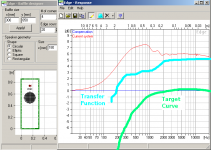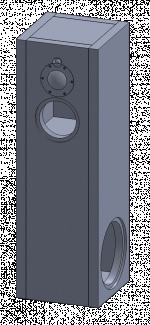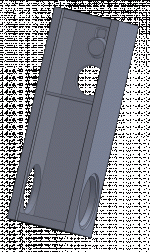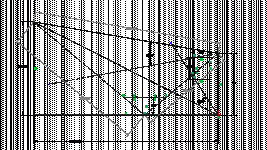Check it out, let me know what you think. Still a design concept, no actual work done.
I still think the enclosure is kind of ugly. Oh well. What will make it worse is that I want to use felt all around the upper 4 drivers.
Couple of things to note: the baffle is shared, but the inner air space is not. Uh, also, I won't be able to really select the proper crossover point between the sub and the lower mid until I measure the drivers in-baffle.
I still think the enclosure is kind of ugly. Oh well. What will make it worse is that I want to use felt all around the upper 4 drivers.
Couple of things to note: the baffle is shared, but the inner air space is not. Uh, also, I won't be able to really select the proper crossover point between the sub and the lower mid until I measure the drivers in-baffle.
Attachments
Last edited:
Member
Joined 2009
Would you suggest taking out a driver or replacing two of them with a different one?It looks alright so far. I think that you might be able to meet the requirements with a 4-way design. Also I think that separate subwoofers can give you more flexibility with room placement especially if you can time-delay them with DSP.
Going 4-way is a definite possibility but I couldn't really see how without running into either beaming (even however slight) or high center-to-center spacing.
Something came up that is being rather irksome. I now want to attenuate the effect of floor bounce, and at my listening position, the dip is centered around 290 Hz. Unfortunately, with the crossover at 250 Hz, the cone mid is definitely going to effect the dip.
Now, the easy solution is to push the woofer up as high as possible, but center-to-center gets quite high (up to 3/4 wl). I suppose I could drop the crossover point a little, say to 350-400 Hz, and compensate with the proximity to the dip with an ~8th-order elliptic filter, Jon Marsh/Bob Ellis-style, but still...
Ideas?
Now, the easy solution is to push the woofer up as high as possible, but center-to-center gets quite high (up to 3/4 wl). I suppose I could drop the crossover point a little, say to 350-400 Hz, and compensate with the proximity to the dip with an ~8th-order elliptic filter, Jon Marsh/Bob Ellis-style, but still...
Ideas?
Member
Joined 2009
There are a few options to explore but I would start with trying to eliminate the 1" tweeter. I've had success with crossing over the Vifa NE19VTA-04 very low and Zaph's measurements suggest it's good to about 2kHz. I also cut out the flange to get better center-to-center spacing (it's aluminum). I don't do 110dB so you should run some experiments to see how it holds up.
If you are willing to spend the money (you save some by eliminating a driver) the ScanSpeak D2004/6020 looks great.
If you are willing to spend the money (you save some by eliminating a driver) the ScanSpeak D2004/6020 looks great.
Unfortunately the NE19VTA doesn't measure quite as well as the Aura or the DQ25SC16, and at this point I would have no way of knowing whether the difference is audible. I really do not want to cut more than one baffle.There are a few options to explore but I would start with trying to eliminate the 1" tweeter. I've had success with crossing over the Vifa NE19VTA-04 very low and Zaph's measurements suggest it's good to about 2kHz. I also cut out the flange to get better center-to-center spacing (it's aluminum). I don't do 110dB so you should run some experiments to see how it holds up.
If you are willing to spend the money (you save some by eliminating a driver) the ScanSpeak D2004/6020 looks great.
Any clues about the floor bounce?
Still looks like the Aura is the better tweeter for now. If I run it straight to the RS52, I can get better than 1/2 wavelength spacing, but at the 2 kHz required to avoid the beaming of the 2" dome, I can only get 105 dB half-space out of the tweeter, assuming 0.6mm p-p Xmax and not 0.6mm one-way.
Three things help: 1) my calcs tell me "average" music will need only about 103 dB, with excursion weighted around the high-pass but sparingly distributed, 2) a 4th-order LR will give me a -3 dB dip at the high-pass. Still, pushing it a little bit, and 3) HD tends to be harder to hear in a tweeter since 3/4/5th-order is so high up in frequency.
Three things help: 1) my calcs tell me "average" music will need only about 103 dB, with excursion weighted around the high-pass but sparingly distributed, 2) a 4th-order LR will give me a -3 dB dip at the high-pass. Still, pushing it a little bit, and 3) HD tends to be harder to hear in a tweeter since 3/4/5th-order is so high up in frequency.
Couple of changes... it looks better, at least.
Too tired to put up the worksheet, but a few notes now:
- drivers are Aura NT1-204-8D, Dayton RS52AN-8, SB17NRX35C-4, 2x Dayton RSS265HO-4
- obviously, the RS52 was modeled without the flange cutout for the dome tweeter
- the brace in the middle is solid and helps keep the two bass drivers from affecting the cone mid
- the lower air space is a ~1.3 cubic foot vented enclosure, tuned to 30 Hz. F3 is at approx 35 Hz.
- outer dimensions are 320 mm x 320 mm x 1000 mm
Too tired to put up the worksheet, but a few notes now:
- drivers are Aura NT1-204-8D, Dayton RS52AN-8, SB17NRX35C-4, 2x Dayton RSS265HO-4
- obviously, the RS52 was modeled without the flange cutout for the dome tweeter
- the brace in the middle is solid and helps keep the two bass drivers from affecting the cone mid
- the lower air space is a ~1.3 cubic foot vented enclosure, tuned to 30 Hz. F3 is at approx 35 Hz.
- outer dimensions are 320 mm x 320 mm x 1000 mm
Attachments
Last edited:
hi 454Casull, I would recommend this tweeter:
Dayton Audio ND16FA-6 5/8" Neodymium Dome Tweeter 275-025
its inexpensive, it sounds great, its small, it complements dome's sound character well, and it has been used succesfully with dayton dome
I have used it few times, and zaph has 3.5 design with it as well, so you can get some info on the crossover...
Dayton Audio ND16FA-6 5/8" Neodymium Dome Tweeter 275-025
its inexpensive, it sounds great, its small, it complements dome's sound character well, and it has been used succesfully with dayton dome
I have used it few times, and zaph has 3.5 design with it as well, so you can get some info on the crossover...
He used the ND20FB, and that was crossed at 3.5 kHz. A 5/8" dome compared to the 3/4" dome would have to cross even higher, and I need the tweeter to go down to 2.2-2.4 kHz in my 4-way. In the 5-way, it might've replaced the Aura...hi 454Casull, I would recommend this tweeter:
Dayton Audio ND16FA-6 5/8" Neodymium Dome Tweeter 275-025
its inexpensive, it sounds great, its small, it complements dome's sound character well, and it has been used succesfully with dayton dome
I have used it few times, and zaph has 3.5 design with it as well, so you can get some info on the crossover...
Member
Joined 2009
I like the latest iteration very much. This will be a top class speaker.
I don't know what your access to resources is but I have another very experimental suggestion. You can calculate the width of the baffle to make it so that the baffle step falls on the crossover between the subs and the midwoofer. With DSP and measurements you can use the baffle step as a part of the highpass crossover. This way your system will gain a few dB by not having to use a baffle step compensation. It's a tricky mess but you have a few dB to gain and not much to lose. In worst case scenario you can't get it to work and will end up doing a baffle step compensation anyway.
I don't know what your access to resources is but I have another very experimental suggestion. You can calculate the width of the baffle to make it so that the baffle step falls on the crossover between the subs and the midwoofer. With DSP and measurements you can use the baffle step as a part of the highpass crossover. This way your system will gain a few dB by not having to use a baffle step compensation. It's a tricky mess but you have a few dB to gain and not much to lose. In worst case scenario you can't get it to work and will end up doing a baffle step compensation anyway.
This is what I was trying to do. I won't be able to do it perfectly now because I also want to get rid of floor bounce (and also because the baffle is rectangular and not square/circular), but it should still work to some degree.I like the latest iteration very much. This will be a top class speaker.
I don't know what your access to resources is but I have another very experimental suggestion. You can calculate the width of the baffle to make it so that the baffle step falls on the crossover between the subs and the midwoofer.
With most speakers, baffle step results in extra midbass energy going into the room. Midrange and treble is half-space, and so is bass if a sub is used, but I want to reduce this "bloat".
Didn't really think of incorporating it into the crossover. Probably would've come up anyway.With DSP and measurements you can use the baffle step as a part of the highpass crossover. This way your system will gain a few dB by not having to use a baffle step compensation. It's a tricky mess but you have a few dB to gain and not much to lose. In worst case scenario you can't get it to work and will end up doing a baffle step compensation anyway.
Member
Joined 2009
This is what I was trying to do. I won't be able to do it perfectly now because I also want to get rid of floor bounce (and also because the baffle is rectangular and not square/circular), but it should still work to some degree.
If I'm not mistaken the floor bounce frequency is around 300Hz. That translates to about a foot of baffle width.
Didn't really think of incorporating it into the crossover. Probably would've come up anyway.
DSP makes prototyping much easier. Whether or not it makes it in the finalized speaker it's really useful to have around when designing the crossovers. There are a bunch of computer solutions that can be realized for very cheap.
Right.If I'm not mistaken the floor bounce frequency is around 300Hz. That translates to about a foot of baffle width.
That means that the low-pass of the cone mid should be higher than that, ideally an octave or more, but in this case only ~100 Hz more, necessitating a very high order of filter. The other two problems are that the c-c distance to the subs gets very high, and then the subs will get more directive (dip in the power response) since I can't shrink the baffle width even more without going to 8" drivers - my bass is disappearing!
Member
Joined 2009
Here's a quick picture to illustrate my point. Please excuse the free-hand curves. It will be hard to figure out the exact Transfer Function but with a good measuring setup it's doable.

The subs c-c distance is certainly something to worry about. Another solution will be to use a single 15" sub on the side.

The subs c-c distance is certainly something to worry about. Another solution will be to use a single 15" sub on the side.
Usual notes:
- there will be some directivity at the top end of the sub's passband, but I can deal with a slight dip in power response
- the baffle is as wide as it is to ensure that the cone mid fires only into half space
- the baffle needs those large angles to smooth out the lower end of the cone mid's passband
- the sub is tuned at 22 Hz in a 170 L enclosure, resulting in an F3 of 18 Hz; I expect to need to roll off the lower end in-room
- the device that will attenuate the floor bounce effect is actually not shown yet
- there will be some directivity at the top end of the sub's passband, but I can deal with a slight dip in power response
- the baffle is as wide as it is to ensure that the cone mid fires only into half space
- the baffle needs those large angles to smooth out the lower end of the cone mid's passband
- the sub is tuned at 22 Hz in a 170 L enclosure, resulting in an F3 of 18 Hz; I expect to need to roll off the lower end in-room
- the device that will attenuate the floor bounce effect is actually not shown yet

Attachments
- Status
- This old topic is closed. If you want to reopen this topic, contact a moderator using the "Report Post" button.
- Home
- Loudspeakers
- Multi-Way
- The Pentaview - or the results from my latest inspiration


